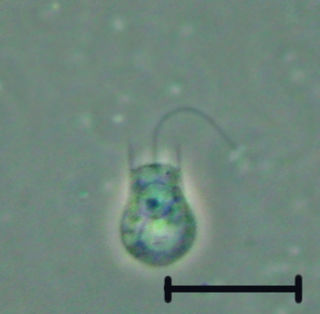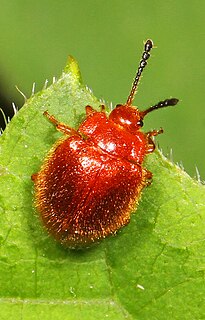
The choanoflagellates are a group of free-living unicellular and colonial flagellate eukaryotes considered to be the closest living relatives of the animals. Choanoflagellates are collared flagellates having a funnel shaped collar of interconnected microvilli at the base of a flagellum. Choanoflagellates are capable of both asexual and sexual reproduction. They have a distinctive cell morphology characterized by an ovoid or spherical cell body 3–10 µm in diameter with a single apical flagellum surrounded by a collar of 30–40 microvilli. Movement of the flagellum creates water currents that can propel free-swimming choanoflagellates through the water column and trap bacteria and detritus against the collar of microvilli, where these foodstuffs are engulfed. This feeding provides a critical link within the global carbon cycle, linking trophic levels. In addition to their critical ecological roles, choanoflagellates are of particular interest to evolutionary biologists studying the origins of multicellularity in animals. As the closest living relatives of animals, choanoflagellates serve as a useful model for reconstructions of the last unicellular ancestor of animals.
Malacocis is a genus of beetles in the family Ciidae, containing the following species:
Perilitus brevicollis is a species of parasitoid wasp in the family Braconidae. The host of this wasp is the blue willow beetle, which is a pest in Europe.
Pachybrachis brevicollis is a species in the subfamily Cryptocephalinae, in the suborder Polyphaga . It is found in North America.

Aulonothroscus is a genus of small false click beetles in the family Throscidae. There are more than 20 described species in Aulonothroscus.
Telmatophilus is a genus of silken fungus beetles in the family Cryptophagidae. There are about seven described species in Telmatophilus.

Curimopsis is a genus of pill beetles in the family Byrrhidae. There are more than 30 described species in Curimopsis.
Notiobia brevicollis is a species of ground beetle in the family Carabidae. It is found in North America.
Xestolabus is a genus of leaf-rolling weevils in the beetle family Attelabidae. There are at least 30 described species in Xestolabus.

Stenotarsus is a genus of handsome fungus beetles in the family Endomychidae. There are more than 50 described species in Stenotarsus.
Acentrinops is a genus of flower weevils in the beetle family Curculionidae. There is one described species in Acentrinops, A. brevicollis.
Dorytomus brevicollis is a species of true weevil in the beetle family Curculionidae. It is found in North America.
Ranatra brevicollis is a species of waterscorpion in the family Nepidae. It is found in Central America and North America.

Derospidea is a genus of skeletonizing leaf beetles in the family Chrysomelidae. There are at least two described species in Derospidea. They are found in North America and Mexico.

Penthe is a genus of polypore fungus beetles in the family Tetratomidae. There are at least three described species in Penthe. Holarctic and Oriental. They live under bark in woody areas.
Podabrus brevicollis is a species of soldier beetle in the family Cantharidae. It is found in North America.

Derospidea brevicollis is a species of skeletonizing leaf beetle in the family Chrysomelidae.
Cryptocarenus is a genus of typical bark beetles in the family Curculionidae. There are more than 20 described species in Cryptocarenus.
Rhypodillus brevicollis is a species of broad-nosed weevil in the beetle family Curculionidae. It is found in North America.
The short-necked skink or Sudan mabuya is a species of skink found in Sudan, Ethiopia, Eritrea, Somalia, Kenya, Uganda, Tanzania, Yemen, Saudi Arabia, and Oman.





